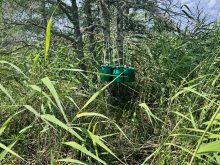Western Canadian farmers loaded 12,784 producer cars during the 2010-11 crop year, the second highest number ever recorded, says the Canadian Wheat Board.
Last year’s loadings fell just short of the record set in the 2008-09 crop year, when producers filled nearly 13,000 rail cars.
Producer car use in the West has increased dramatically over the past decade or so.
Instead of hauling grain longer distances to elevators located on main line railways, farmers load hopper cars at designated loading sites and move them by rail on short-line railways.
Read Also

Research looks to control flea beetles with RNAi
A Vancouver agri-tech company wants to give canola growers another weapon in the never-ending battle against flea beetles.
By loading hopper cars themselves, producers can avoid elevation fees and reduce transportation costs.
Savings vary but shipping costs for a single car of board grains can often range from $1,000 to $1,500, or more.
A decade ago, during the 2000-01 crop year producer car use stood at fewer than 5,000 cars.
But by the 2005-06 crop year, annual loadings surpassed 11,000.
Numbers have remained above the 10,000 per year mark ever since.
The increase in producer car loadings corresponds with the increase in short-line railway operation and the abandonment of branch railway lines by CN and CP.
In the early to mid-1990s, CN and CP ran trains on a combined total of nearly 6,500 kilometres of branch lines and spurs.
Today, the two railway companies have reduced their branch line operations to about 3,250 kilometres of track.
Short-line railway companies, meanwhile, have grown from zero kilometres in 1995 to nearly 1,900 kilometres of track in 2011.
Ed Wallace, a landowner and producer car advocate who grew cereals and pulse crops for nearly 30 years near Success, Sask., estimated that filling producer cars saved him more $50,000 over the past 16 years.
Wallace, who helped form the now-defunct Prairie Producer Car Shippers Association, said the clos u re of elevators along the CP Empress line between Leader, Sask., and Swift Current, Sask., led to a sharp increase in producer car loadings in his area.
CP Empress, which was taken over by Great Sandhills Railway, now ships hundreds of producer cars each year, saving producers elevation fees and expenses associated with transporting grain to the closest mainline elevators at Swift Current or Gull Lake.
Wallace, who retired from farming this year, said he shipped roughly 55 producer cars during the past decade and a half.
“When we started shipping producer cars (in 1995) I think we were paying about $11 a tonne for elevation and handling so multiply that by 90 tonnes,” said Wallace.
“And I think the savings now are quite a bit more than they were back then.”

















